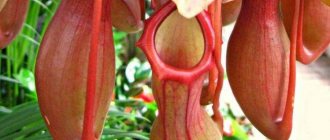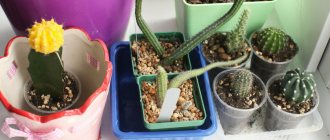Calathea crocata. Photo Calathea belongs to the Marantaceae family. The homeland of calathea is South America, where it grows in tropical rainforests. The plant is hidden from the scorching sun by the spreading branches of tall trees.
Calathea got its name from the word “calathos”, which translates from the Greek “basket” - its leaves were used in ancient times for weaving.
It is a herbaceous perennial plant with many varieties, tuberous and rhizomatous. The leaves grow on elongated petioles and are usually pink or purple on the underside. Blooms from early spring to mid-summer, depending on the species. If the conditions are suitable for her, the flowering period lasts up to 2-3 weeks. The inflorescences are inconspicuous: small flowers are compactly collected in spike-shaped inflorescences. Their color is varied.
| The growth rate is low, up to 7 new leaves per year. |
| Blooms from early spring to mid-summer, depending on the species. |
| The plant is grown with difficulty. |
| It is a perennial plant. |
Photo gallery
In the warm season, calathea feels comfortable at an air temperature of +20–25 °C, in winter not lower than +16–18 °C. In conditions of high humidity, the maximum permissible is +30–35 °C. The lower limit that a flower can survive is +16 °C, after which the roots will begin to rot.
The daylight hours of this plant should last 10–14 hours, so in the cold season you need to use additional lighting. If there is insufficient lighting, the flower stops growing and sheds its leaves.
Calathea needs high air humidity - at least 60%, and preferably 90–95%. Therefore, the air near the flower needs to be sprayed frequently, especially in winter. You can also increase the humidity level by placing a container of water next to the flower.
During the flowering period, you need to feed the calathea with fertilizer for flowering plants, such as Agricola, once every 14 days. Afterwards, the faded flowers should be trimmed, leaving 5 cm and removed completely when they dry out.
How to care for autumn and winter?
With the onset of cold weather, the calathea prepares for sleep. Its metabolic process is significantly reduced, so the amount of fertilizer applied is reduced. But Calathea Saffron, which begins to bloom during this period, must continue to be fed according to the usual scheme.
The liquid content in the pot in the autumn-winter period is also important. Water the flower only when the soil is one third dry. If the room temperature is not high, watering is done when the soil is half dry. It must be remembered that a tropical plant does not require a strong drop in temperature for wintering, otherwise it will freeze.
Where can I buy a plant?
You can buy calathea in offline and online flower shops. The cost ranges from 200 to 3 thousand rubles, depending on the type and size of the plant.
What to do immediately after buying a flower?
You need to accustom the plant to new conditions gradually; to do this, you need to place it for 2 weeks in a bright but shaded place where it is warm, there are no drafts or dampness.
After adaptation, the calathea must be replanted, completely replacing the soil and flowerpot, treated with Zircon using a spray bottle and watered generously.
What kind of pot do you need?
Calathea has a superficial root system that grows in breadth, so the pot needs to be low and wide, shaped like a bowl. Each new container should be 4–5 cm larger in diameter than the previous one.
The most suitable material is unglazed ceramics, which provides access to the required volume of oxygen to the roots.
The pot must have drainage holes, and during replanting it is necessary to lay a large layer of drainage on the bottom, which can be large pebbles, ceramic shards or expanded clay.
What kind of soil is needed?
The soil for calathea should be moisture-permeable, nutritious, have good aeration and weak (pH 5.0–6.0) or neutral (pH 6.0–7.0) acidity.
You can use ready-made soil for arrowroot or azaleas, or prepare it yourself by mixing in equal parts:
- high peat;
- leaf soil;
- humus;
- coarse sand.
To deoxidize the resulting substrate, you need to add crushed charcoal to it at the rate of 40 grams per 1 kg of soil mixture.
The soil should not contain lime.
To get rid of pests, the soil mixture must be steamed in a water bath, poured with a weak solution of manganese, calcined in the oven, or treated with insecticides and fungicides, such as Aktara, Aktellik or Fundazol.
Transfer
Due to the specific toxins released into the soil by the roots of the plant and leading to its death, replanting is a necessary procedure for calathea. It is better to carry it out in early spring.
Reasons for transplant:
- disease;
- growth of the root system;
- 14 days have passed since the purchase.
Before the calathea reaches 3 years, it needs to be replanted annually, then every 2-3 years.
Transplant instructions:
- water the plant generously 1.5 hours before transplanting;
- Place a drainage layer a quarter of the height of the container on the bottom of the flowerpot, sprinkle it with crushed charcoal or activated carbon to prevent root rotting;
- pour a layer of soil on top not exceeding 2–3 cm;
- carefully remove the calathea from the old container along with a lump of earth;
- rinse the roots in cool water;
- cut all damaged roots with a sharp knife strictly perpendicularly, remove old and dry leaves;
- treat the cut areas with crushed activated carbon or wood ash;
- place the plant in a new pot and soil, carefully straighten the roots;
- make sure that the growing point is strictly in the center of the flowerpot and above the soil surface;
- carefully pour the soil into the pot, leaving 1.5–2 cm to its upper edge;
- lightly press, but do not compact the soil.
After replanting, it is necessary to water the calathea generously and put it away for 2-3 days in a cool place where direct sunlight does not penetrate. The next watering is carried out after 8–10 days.
Calathea propagation
The plant can be propagated in three ways: division, cuttings and seeds.
Reproduction of calathea by dividing the bush
Most often, calathea is propagated by dividing the bush - this is the most effective way, which allows the seedling to quickly adapt and begin to grow. Only healthy and large plants are suitable for division.
The bush is disassembled by hand so that each part has 2-3 leaves and several high-quality roots. Divisions that are too small take root very poorly and may die.
The seedling is immersed in light soil of peat and sand, the upper part is covered with a plastic bag, maintaining high humidity underneath. When growth and the appearance of new leaves are noticeable, the plant is transferred to normal conditions.
Propagation of calathea by cuttings
Propagation by cuttings is available for calathea. In this case, a stem with a length of 15 cm is selected. It should have a growing point and 3-4 leaves. The stem is planted in a substrate of peat and sand.
The pot is left in a warm and very humid place until the cuttings take root.
Growing calathea from seeds
Not the most popular way to propagate calathea is through seeds. They are laid on the soil surface for several weeks, slightly pressed down on top, and covered with glass on top to create a greenhouse effect. After germination, they should be sprinkled with 1 cm of soil.
When sprouts appear, you need to start airing: remove the glass for 30 minutes. If the plants have reached 2-3 cm in length, then it’s time to replant them in separate pots and care for them as usual.
Fertilizer and feeding
During the growing season (from early April to September), you need to apply fertilizers every 2 weeks, and in the fall and winter, if the plant is in satisfactory condition, reduce the number of fertilizing to once every 1.5-2 months or completely abandon them.
Suitable fertilizers are intended for plants of the Marantaceae family or universal fertilizers for decorative deciduous indoor flowers, for example, Bona Forte, Pokon, Agricola or Etisso.
Calathea reacts negatively to excess nitrogen and calcium; the content of these elements should be reduced.
Fertilizing should be done 10–15 minutes after watering; the plant should not be fertilized on dry soil.
General information
Calathea is one of the representatives of the Marantaceae family. The plant's homeland is considered to be South and Central America, although it is found in almost all tropical zones.
The Calathea genus is extensive and includes many decorative deciduous herbaceous or liana-like perennials. The leaves of most of them are oblong-oval or lanceolate, collected in rosettes. Their distinctive feature is a pattern of geometrically regular, symmetrical spots. The lower part is most often colored purple and sometimes has pubescence. Like related arrowroots, the leaves of some species may fold and droop after dark. For this feature they are called prayer flowers.
The size of the bushes can reach 1.5 m, but indoor varieties are more compact. The shoots are mostly underground, less often short vertical. Some varieties form only one true leaf per rosette; others “release” 5-6. The leaves quickly evaporate moisture, so in arid climates the plant dies. With the exception of two species, calatheas do not bloom. After flowering, the above-ground part may die off.
Watering
On average, it is necessary to water calathea 2-3 times a week in summer, and once every 7-8 days in winter, but it is better to focus on the condition of the top layer of soil - it should dry out 2-4 cm.
The water from the pan must be drained after 20–25 minutes. Stagnation of moisture should not be allowed, as it leads to rotting of the roots.
It is necessary to avoid getting water on the leaves of the calathea, so for watering it is better to use a watering can with a narrow spout, and for spraying - a spray bottle that sprays small drops. Water getting on the leaves leads to the appearance of dark spots on them.
Water for irrigation and spraying should be soft, ideally rain or melt, and have a temperature not lower than +25–26 °C.
Calathea varieties with velvety leaves cannot be sprayed.
If you are going on vacation
You can leave the calathea unattended for no longer than 3–5 days; over a longer period it may die.
The plant cannot be watered in advance or the watering process cannot be controlled; this will lead to rotting of the roots, and without moisture the calathea will dry out.
Popular types
Brazilian Calathea Makoya is ideal for growing in greenhouses. It has large oval leaves of light green color with a dark border, on which a dark green pattern stands out. The pattern on the upper surface of the leaf blade is similar to an imparipinnate leaf, and the back side is painted burgundy.
Calathea saffron, or crocata, grows wild along the banks of the Amazon. It has large velvety leaves of an emerald green color with a metallic tint, without a pattern. Often bright false flowers forming corymbose inflorescences are mistaken for real ones. Crocata blooms not only in spring and autumn, but also in winter.
The plant prefers root watering, since when drops of water get in, the integrity of the leaves is damaged. Direct sunlight causes burns .
Another type of flowering plant is represented by Varshevich's calathea. This variety has attractive not only velvety dark green leaves with wavy edges, but also magnificent white or cream-colored inflorescences reminiscent of roses.
Calathea saffron and crocata are also known as Prayer Flowers. This name arose due to the characteristic feature of raising the leaves upward in the evenings, which gives a resemblance to the hands of praying people raised to the sky. By morning, the leaf blades return to a horizontal position again .
Pests. Table
| Name | How to detect? | How to save? |
| Spider mite | A thin, barely noticeable white web appears on the bottom of the leaves. The leaves begin to curl, turn yellow and dry out. | wipe the leaves with a warm soapy solution, spray the plant with acaricides (Apolo, Borneo, Envidor), systemic (Biotlin, Calypso) or enteric-contact insecticides (Fitoverm, Actellik). |
| False scale insects | Pests feed on the sap of the plant and secrete a lot of sticky excrement, which is why the leaves become sticky, begin to shine, and become covered with a gray or black coating. Young leaves dry out and old leaves turn yellow. | •Wipe the calathea with cotton wool soaked in 70% alcohol or soap suds, repeat the procedure 4 times every 5–7 days; • spray with an insecticide, for example “Aktara”, “Aktellik” or “Intavir”. |
| Mealybug | Cotton-like pellets appear on the stems, in the axils of the leaves, near the root collar, and plant growth slows down. | Wash the plant with soapy water, diluting 20 grams of soap in 1 liter of water. In case of severe infection, treatment with Mosplan, Decis or Fitoverm insecticides is required. |
| Whitefly | A shiny, sticky coating appears on the leaves; when you shake the plant, you can see insects flying out of it. | Treat twice with an interval of 10 days with Verticillin or Pegasus or once with Confidor, Mospilan or Fufanon. |
About the history of appearance
The homeland of calathea is South America. Its usual name is galatea, in printed publications it is called calathea.
Amazing purity of shades of striped calathea
The first name of the flower is “crown of the Incas”; calathea received it because of the appearance of the flower and its distribution area: Peru, Brazil, Bolivia.
The second is a “prayer flower”, due to the fact that its leaves rise up in the evening, revealing the lower side, and in the morning they fall to their previous position, resembling hands raised in prayer.
The plant was brought to Europe by the conquistadors - the Spanish and Portuguese conquerors of America.
Problems with leaves. Table
| Symptoms | Causes |
| The tips of the leaves dry out and wither | Insufficiently humid air in the room. |
| Yellow or brown, but do not dry out. | Excess fertilizing or cold air, draft. |
| Leaves fall. | •low air humidity; •excessive watering; •acid soil. |
| The leaves dry out and curl. | If this is accompanied by a slowdown in growth, it means that the calathea does not have enough moisture or fertilizing. |
| Light spots on the leaves. | Sunburn caused by direct sunlight. |
| The leaves become long, thin and light. | Calathea lacks light. |
Diseases
With proper home care, the flower is resistant to diseases, but excessive watering can lead to root rot. In this case, it is necessary to urgently replant the plant with a complete replacement of the soil and flowerpot, removing all damaged parts of the flower.
Errors when leaving
As a result of improper care, calathea loses its decorative appearance, it is affected by diseases and pests, and the plant dies. Thus, the wrong choice of soil and an inappropriate level of humidity in the room cause problems with the leaves of the flower, which lose their decorative effect, dry out and fall off, and excessive watering leads to rotting of the roots.
What you need to know about the flower
Calathea is a plant of the second tier of the tropical forest and belongs to the Marantaceae. Calathea leaves are oval and elliptical, up to 30 cm long. They are velvety and glossy, the back part always has red shades in color. You can admire the complex pattern of the leaf plate endlessly.
The leaves grow on the stem, but it is short, the internodes are millimeters apart from each other, it seems that the rosette is growing from the ground. The length of leaf petioles varies. Surprisingly, the flower loves classical music and cannot stand tobacco - an esthete!
Improper care of calathea at home will destroy the plant.











